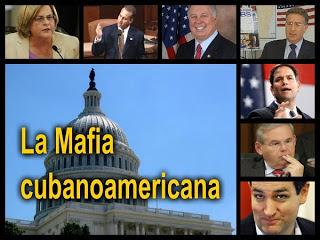Origins of the Cuban-American mafia of Miami
- Opinión

Miami, Florida, is considered in political circles around the world as the home of the worst of the Cuban community in North America. As a safe haven for some of the most dangerous terrorists in the country and the world, in that country’s plight, they have established many garrison headquarters that control illicit businesses related to arms, drugs and human trafficking.
But it has not always been this way. The story was told by Mario Puzo in his books and films about the violent methods used by the first Italian mafia groups of immigrants, who changed their ways to adapt to the American Way of Life. This even reached the level of high politics of the United States, and can be compared with the history of the Cuban mafia of South Florida.
In 1959, hundreds of corrupt politicians and servants of the defeated Batista tyranny began to arrive in Miami with bags stuffed with dollars stolen from Cuba’s public treasury. There were hundreds of torturers and murderers among them. They were organized and re-organized by the CIA and other agencies of the United States government to be used in military and terrorist acts against the Cuban revolution and other misdeeds of the extreme right-US in the world. These fearsome “refugees” were the germ of what came to be the powerful Cuban-American mafia in Miami when they joined other elements of the subsequent Cuban emigration.
Meanwhile, the American extreme right, using its intelligence and subversion organizations, organized various terrorist groups of Cubans. They were recruited from among the émigrés and on the island. Their goal was subverting order in Cuba and creating the conditions for military invasion and re-occupation of the island.
After the roaring failure of the Bay of Pigs invasion, the American extreme right intensified hundreds of other terrorist projects that also went down in defeat.
They then opted for a tactical change that gradually turned the cleverly-made Cuban terrorists into politicians who controlled US foreign policy toward Cuba for almost half a century and through the administration of twelve different US presidents.
The process of legitimizing the representatives of Cuban-American mafia in the political establishment of the United States was fast and effective. They learned the game of politicking, opportunism, and fraud. Soon they had several members of congress, senior executive officials and ambassadors, as well as a number of members of the judicial power in Florida. They incorporated to this learning their methods acquired during the bloody dictatorship of Batista in Cuba. Some of these groups, since 1959, have been imposing methods of pressure comparable to those of the Chicago gangsters in the 30s or 40s of last century to manipulate the population of Cuban immigrants in the United States.
The Cuban-American mafia of South Florida has carried out numerous terrorist acts. They have participated in political crimes funded by the extreme right US policy as much in Cuba as in the United States as well as in other countries in Latin America and Europe.
They have been involved in electoral tricks and political scandals involving Latin American countries and in the United States as well. They know the protagonists of Watergate and the electoral fraud in Florida that gave George W. Bush the presidency in 2000. It is known that they were involved in the assassination of President John F. Kennedy. It was not just that they were politicians and officials of Cuban origin, not only that. They were “Cuban-Americans” clearly aligned with the extreme right of the country, recently detached from the ranks of known terrorist elements with links to Miami.
There have been attempts to get Cuban-Americans to lead Latinos in the political establishment, but the interests and ambitions of both groups have been incompatible.
Cuban-American politicians, with honorable exceptions, are a more homogenous and manageable group than other Latino immigrants because, as a rule, they respond uniformly to the interests of those who promote them, because they are something like laboratory politicians, cloned and breastfed by the conservative forces to which they owe their promotions.
However, at present, we must take into account that three-quarters of the Cubans who emigrated to the United States after 1980, did so for economic reasons. Because of this, they are carriers of many of the ethical, moral and patriotic values of the revolution. Sooner or later they will end up imposing coexistence with Havana, making the business of the counterrevolution, with which the Cuban-American mafia made its fortune, obsolete.
October 13, 2017.
- Manuel E. Yepe http://manuelyepe.wordpress.com/
Del mismo autor
- ¿Por qué la sostenida popularidad de Trump? 20/07/2020
- Ya no es la economía, estúpido, es el virus 15/07/2020
- De qué no será capaz Trump para reelegirse 02/06/2020
- The Capitalist Crisis is Worse than Covid-19 26/05/2020
- Refutación del fundamentalismo religioso 19/05/2020
- Precedents in Cuba of “Operation Gideon” 16/05/2020
- Precedentes en Cuba de la Operación Gedeón 14/05/2020
- Los grandes perdedores del Super Bowl 18/02/2020
- El papel del miedo en las elecciones de EEUU 11/02/2020
- Impacto de Trump en la juventud de EEUU 24/01/2020
Clasificado en
Clasificado en:
Cuba-EEUU
- Manolo de los Santos, Vijay Prashad 01/11/2021
- Rosa Miriam Elizalde 31/10/2021
- José Ramón Cabañas Rodríguez 10/09/2021
- José Ramón Cabañas Rodríguez 09/09/2021
- Gilberto Lopes 04/08/2021
